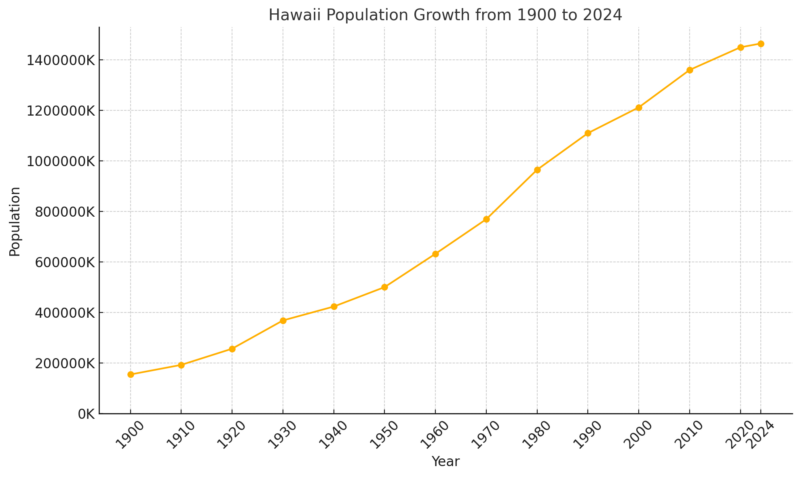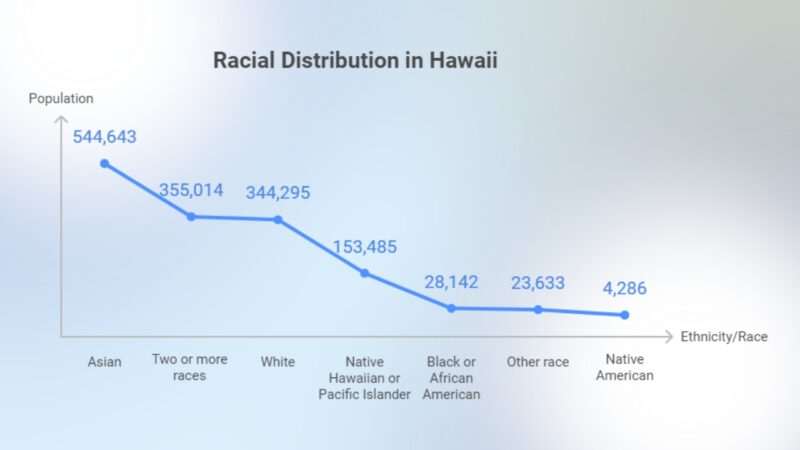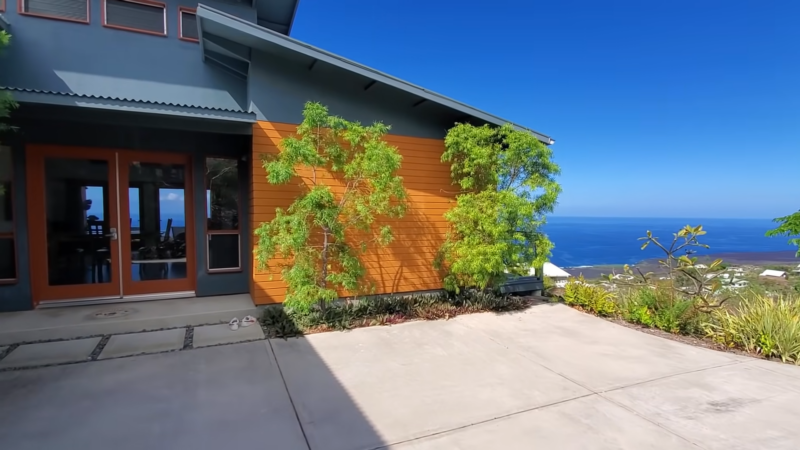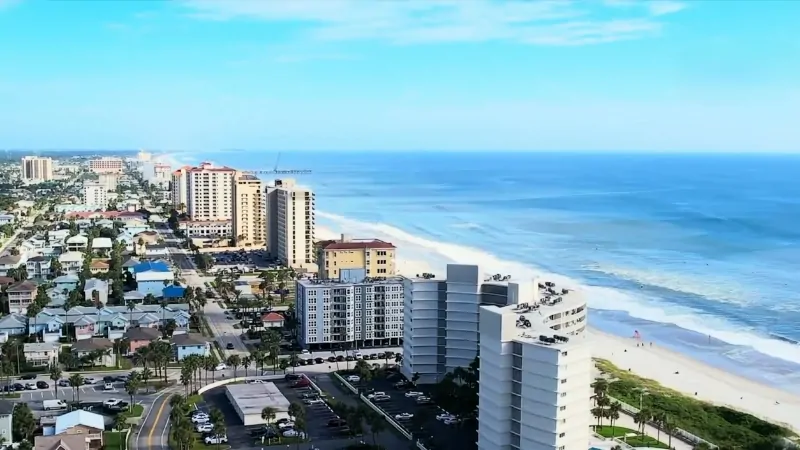Hawaii’s population continues to evolve, reflecting trends in migration, birth rates, and demographic shifts.
As of 2025, estimates suggest that Hawaii’s population stands at approximately 1.44 million, showing a slight decline compared to previous years.
Hawaii’s growth has fluctuated over the past few decades, with significant changes observed recently.
Table of Contents
ToggleKey Takeaways
- Hawaii’s population is estimated at 1.44 million in 2025, showing a 0.30% decline since 2022 due to outmigration and economic challenges.
- Hawaii features a diverse racial composition, with a median age of 39.6 years and a balanced sex ratio (50.37% males, 49.63% females).
- High costs of living and housing have led to net migration losses, though international immigration from Asia and the Pacific Islands helps offset some of these declines.
- Tourism remains a key economic driver, contributing $17 billion in 2023, but rising housing prices and workforce shortages challenge affordability and growth.
- Delayed healthcare access affects 58% of residents, especially in rural areas, with workforce shortages further straining the system.
- Population is expected to stabilize and grow slightly to 1.56 million by 2050, with strategic economic and policy efforts needed to sustain growth and quality of life.
Demographics
Hawaii’s population in 2025 is estimated at approximately 1.44 million according to data from Statista.
This figure reflects a slight decline from previous years, indicating a population decrease of about 0.30% since 2022.
Racial Composition
The racial distribution in Hawaii is diverse.
The following percentages represent major demographic groups:
Populations By County
Rank
County
Population
1
Honolulu County
989,408
2
Hawaii County
207,615
3
Maui County
164,183
4
Kauai County
73,851
5
Kalawao County
81
Age Distribution
Median Age
The median age in Hawaii is 39.6 years, which is slightly higher than the national median. When broken down by gender, we observe that males have a lower median age of 38.3 years, while females have a higher median age of 40.9 years. This suggests that, on average, women in Hawaii tend to live longer than men.
Adult Population
Hawaii has a total of 1,142,478 adults, a significant portion of the population.
Among these adults, 268,789 are seniors, indicating a sizable elderly population that may require specialized healthcare and support services.
Age Dependency
Hawaii’s age dependency ratio is 66.4, meaning that for every 100 working-age individuals, there are approximately 66 people who are either children or elderly and dependent on others for support.
The child dependency ratio is 35.6, representing the proportion of children under the age of 18 dependent on the working-age population. Meanwhile, the old age dependency ratio is 30.8, showing the share of elderly individuals reliant on working adults.
Sex Ratio
The sex ratio in Hawaii is slightly skewed towards males. There are 732,172 men, comprising 50.37% of the population, compared to 721,326 women, who make up 49.63% of the population. Although the difference is small, Hawaii’s gender ratio indicates a balanced distribution between men and women.
Population Growth Over the Years
While the overall population has seen fluctuations, historical trends indicate that Hawaii’s population has experienced a growth of 222,742 since 2000 as per USAfacts. Continued monitoring of demographic data will provide further insights into these trends.
Notably, the largest annual population increase occurred between 2019 and 2020, when the state saw a 2.5% rise. Conversely, the most significant decline was between 2018 and 2019, marked by a 0.5% drop. These fluctuations illustrate the dynamic nature of Hawaii’s demographic landscape.
Census Data Insights
Hawaii’s census data reveal detailed insights into the state’s population distribution and characteristics.
According to the 2010 census, the population was recorded at 1,360,301, rising to an estimated 1,431,603 by 2015. This growth reflects a 5.2% increase within five years.
Subsequent estimates indicate that the population has stabilized in recent years.
Migration Patterns
Migration patterns have played a critical role in shaping Hawaii’s population trends over the past decade. Between 2010 and 2022, the state experienced population increases in 7 out of 12 years, with an average annual growth rate of approximately 0.5%, according to the U.S. Census Bureau and data from the Hawaii State Department of Business, Economic Development & Tourism (DBEDT).
Several factors drive migration to and from Hawaii. Economic opportunities, such as the availability of jobs in tourism and the military, have attracted new residents, while the high cost of living and limited housing have caused others to leave.
Moreover, the state has been experiencing net migration losses during specific periods, particularly when the local economy faltered, leading to negative population growth.
According to DBEDT reports, Hawaii saw an exodus of residents to the U.S. mainland, where the cost of living is often lower, affecting overall population dynamics.
Education also plays a significant role in Hawaii’s migration trends.
Many young residents leave the state to pursue educational opportunities elsewhere, contributing to a “brain drain,” while some professionals are drawn back after completing their studies.
Additionally, the state has seen steady immigration from international sources, notably from Asia and the Pacific Islands, which helps offset some of the population losses caused by domestic migration.
Quality of life factors, including Hawaii’s unique lifestyle and natural beauty, continue to attract retirees and others seeking a more relaxed pace of life.
However, these factors are sometimes offset by economic challenges, leading to a delicate balance between inflows and outflows of residents.
Economic Impact
Labor Market Dynamics
| Data Series | May 2024 | June 2024 | July 2024 | Aug 2024 | Sept 2024 | Oct 2024 (p) |
|---|---|---|---|---|---|---|
| Civilian Labor Force (in thousands) | 669.6 | 669.9 | 670.9 | 670.3 | 670.4 | 671.2 |
| Employment (in thousands) | 649.5 | 650.6 | 651.7 | 651.1 | 651.1 | 651.9 |
| Unemployment (in thousands) | 20.0 | 19.4 | 19.2 | 19.2 | 19.3 | 19.3 |
| Unemployment Rate (%) | 3.0 | 2.9 | 2.9 | 2.9 | 2.9 | 2.9 |
- (p) indicates preliminary data for October 2024.
- Data provides insight into Hawaii’s labor market stability, with a consistently low unemployment rate across the months according to BLS.
As a result, employers may need to offer higher wages and improved benefits to secure workers, a trend that could further drive inflation and cost pressures in the economy according to DBEDT.
Population and Tourism
Tourism remains one of the most vital drivers of Hawaii’s economy. In 2023, Hawaii welcomed approximately 9.1 million visitors, contributing over $17 billion to the local economy.
Despite a projected 2% annual growth in visitor numbers through 2027, local challenges such as population stagnation may impact visitor experiences, as businesses and amenities reliant on a larger workforce struggle to keep up with demand according to UHERO.
Moreover, areas like Maui saw significant declines in tourism following recent events, which has had ripple effects across other islands(
Housing Market Effects
Redfin notes that Hawaii’s home prices have seen significant year-over-year growth. In August 2024, the median sale price was $783,300, which represents an 11.7% increase compared to the same time last year. This indicates that the market remains competitive, and homebuyers are paying more to secure properties.
Metric
Value (August 2024)
Change Year-over-Year
Median Sale Price
$783,300
+11.7%
Number of Homes Sold
1,019
-5.2%
Median Days on Market
76
+12 days
Fastest Growing Metro Areas by Sales Price
Certain areas in Hawaii are experiencing even more significant price increases. Hawaiian Paradise Park, for example, saw a 30.4% increase in home prices, while Wailea and East Honolulu had growth rates of 21.4% and 16.3%, respectively.
Metro Area
Price Growth % (YoY)
Hawaiian Paradise Park, HI
+30.4%
Wailea, HI
+21.4%
East Honolulu, HI
+16.3%
Kihei, HI
+13.9%
Honolulu, HI
+11.9%
Housing Supply
The number of homes available for sale in Hawaii has also increased. As of August 2024, there were 6,842 homes for sale, marking a 29.4% increase compared to last year. This growth in housing supply suggests that more options are becoming available for buyers, although homes are staying on the market longer than before.
| Metric | Value (August 2024) | Change Year-over-Year |
|---|---|---|
| Number of Homes for Sale | 6,842 | +29.4% |
| Number of Newly Listed Homes | 1,322 | +9.6% |
| Months of Supply | 6 months | +2 months |
This data shows that while the Hawaii housing market remains competitive, with rising prices and homes taking longer to sell, the increased housing supply may ease some pressure on buyers. For more detailed insights, this data is based on calculations by Redfin from MLS and public records.
Educational System Adjustments
Hawaii’s public school system continues to evolve, marked by both progress and challenges. The Strive HI Performance System, designed by the Hawaii Department of Education, measures student achievement across various metrics beyond standardized testing, focusing on overall student readiness for college and careers.
According to recent reports, Hawaii’s public schools have shown promising improvements in key academic areas:
- English Language Arts proficiency increased by 2% to 52%.
- Math proficiency saw a notable 6% rise, now at 38%.
- Science competency also improved, climbing 5% to 40%.
These gains are encouraging, particularly after the disruptions caused by the COVID-19 pandemic, which severely affected classroom attendance and learning. Some schools, like Kaunakakai Elementary School on Moloka’i, witnessed a dramatic rise in absenteeism—up to 63%—but also demonstrated resilience with significant gains in English, math, and science proficiencies
Healthcare Services Availability
| Healthcare Access Concern | Percentage of Affected Residents |
|---|---|
| Residents experiencing delays in healthcare | 58% |
| Rural residents (Hawaii Island) under 55 reporting serious delays | 34% |
| Households needing but not receiving mental health support | 28% |
Access to timely healthcare is a significant concern for many Hawaii residents.
Recent assessments have shown that 58% of residents experienced delays in receiving healthcare in the past year, a problem particularly acute in rural regions like Hawaii Island, where 34% of residents under the age of 55 reported serious delays in accessing services.
Mental health services are also under strain, with 28% of households stating they need mental health support but are not receiving it.
These delays and unmet needs illustrate the gaps in healthcare coverage and service availability across the islands.
Workforce Shortages
Hawaii is facing an enduring healthcare workforce crisis. Nearly half of the state’s healthcare providers are considering moving to the mainland due to the high cost of living and low reimbursement rates for medical services.
This has had a profound impact, particularly in rural areas like Maui and Hawaii Island, where the shortage of healthcare professionals is the most pronounced.
Although various measures are being implemented to retain talent, such as loan repayment programs and telehealth expansion, the shortage persists as a major barrier to healthcare access.
The pandemic exacerbated this problem, leading to increased retirements and departures from the healthcare field.
Despite the state’s efforts to address the issue, such as bolstering rural health training programs and providing financial incentives, the shortage of professionals continues to hinder access to essential medical services.
Primary Care and Health Disparities
Disparities in primary healthcare are also a growing concern.
Certain areas of Hawaii, such as Downtown Kalihi and Wailuku, have much higher-than-average rates of chronic conditions like prediabetes, with rates reaching up to 16.9%. In addition, about 4.1% of Hawaii’s population remains uninsured, despite the state’s efforts to improve healthcare coverage.
While this is better than the national average, it highlights the need for ongoing efforts to provide comprehensive care across all regions of the state.
Efforts to Improve the System
The state government, under the leadership of Governor Josh Green, is focusing on several initiatives to tackle these healthcare challenges.
Efforts include raising Medicaid reimbursement rates to encourage more doctors to accept public health insurance, expanding telehealth services to cover more rural communities, and working towards eliminating taxes on medical services to ease financial pressures on healthcare providers.
Additionally, the state is enhancing its local healthcare training programs to ensure a steady pipeline of professionals ready to serve Hawaii’s diverse population.
Government and Policy Responses
The state of Hawaii faces challenges related to its declining population and rising living costs. In response, government initiatives aim to address these issues effectively.
Governor Josh Green’s administration has released a comprehensive policy report addressing these concerns, outlining a framework called The Hawaiʻi We Deserve.
Additionally, discussions during the recent Native Hawaiian Convention have highlighted the importance of including cultural practices in land use and public policy decisions. This engagement can lead to more informed and culturally sensitive decisions regarding the use of resources.
Hawaii’s economic future depends significantly on addressing demographic trends and implementing effective solutions to increase population retention and attract new residents.
Projections and Predictions
Hawaii’s population trends indicate a gradual increase in the coming decades.
According to projections, the resident population is expected to rise from approximately 1.45 million in 2020 to 1.65 million by 2050. This marks an average growth rate of around 0.24 percent per year.
Factors influencing this growth include migration, birth rates, and economic conditions. The current demographic shift shows a slight decline in population in recent years, with a reported drop to 1.44 million in 2023. This represents a 0.30% decrease from the previous year.
Similar trends have been observed in California, where population growth has slowed in recent years due to a combination of outmigration and declining birth rates.
As Hawaii approaches 2030, economists foresee significant demographic changes. There is concern that the state may experience a situation where deaths begin to outnumber births, potentially impacting future population growth.
A summary of Hawaii’s population projections includes:
- 2020 Population: 1.45 million
- 2030 Projection: Expected stability or slight increase
- 2050 Projection: 1.56 million
The challenge of maintaining population growth will depend on various factors, including economic stability and the attractiveness of Hawaii for migration. As trends evolve, monitoring these projections will be essential for understanding the state’s demographic future.
References:
- Statista – Hawaii’s Population in 2024
- U.S. Census Bureau – Population Estimates for Hawaii
- Hawaii Department of Business, Economic Development & Tourism (DBEDT) – Census and Population Data
- Redfin – Hawaii Housing Market Insights
- Bureau of Labor Statistics (BLS) – Hawaii Labor Market Overview
- UHERO (University of Hawaii Economic Research Organization) – Economic Forecast for Hawaii
- Hawaii Public Schools – Strive HI Performance System
- Hawaii Public Radio – Governor Josh Green’s 2024 State Address
- Civil Beat – Hawaii Island’s Population Drop Signals an Ominous Economic Trend
- Hawaii Economic Development Corporation – The Hawaiʻi We Deserve Policy Report
- Hawaii State Department of Health – Healthcare Shortages in Hawaii
- Hawaii Realtors Association – Real Estate Trends in Hawaii
- ES&A Law – Population Growth Projections for Hawaii
- U.S. Facts – Hawaii’s Demographic Changes Over Time
Related Posts:
- North Carolina Population 2025 - Key Stats And Insights
- Missouri’s Population in 2025 - Key Stats and Insights
- Indiana’s Population in 2025 Key Stats and Insights
- Washington State Population Boom in 2025 - Key Stats…
- New Mexico Population 2025 - Key Insights and Stats
- Maine’s Population Growth in 2025 - Key Insights and Trends

















